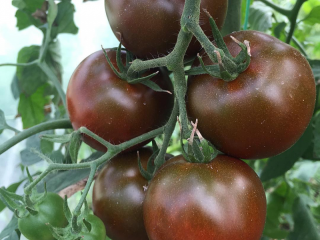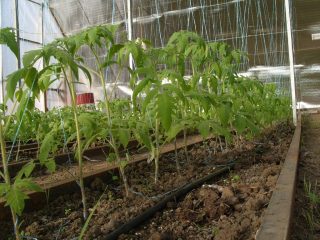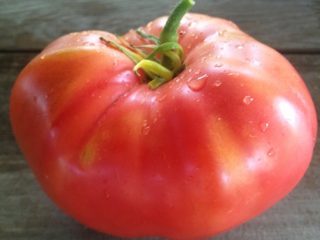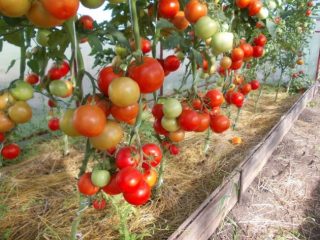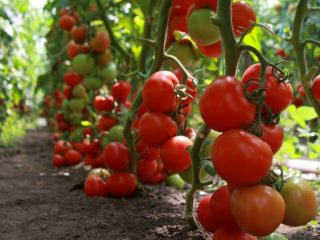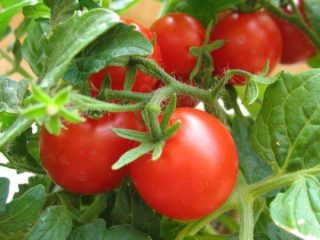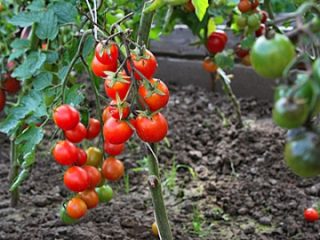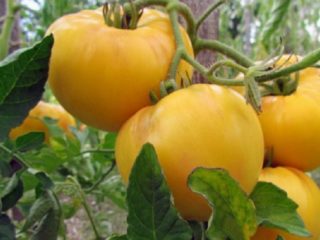Content
The Golden Queen tomato is a promising low-growing variety with round yellow fruits, the juicy aromatic pulp of which has a pleasant sweet taste with fruity notes. It is characterized by high productivity and is valued for its resistance to cracking and the ability to grow in beds and in film greenhouses.
Who brought it out and when?
The Golden Queen tomato is a variety of Russian selection. The tomato was bred by employees of the Siberian Garden agricultural company and has not yet been included in the State Register of the Russian Federation.
Description of the tomato variety Golden Queen
The plant is a low-growing bush of determinate type. Its thick, powerful stems stretch up to 70-100 cm and are covered with rich green leaves of medium size. The tomato plates are covered with a small edge and have pronounced jagged edges. On the surface of the leaves there are veins and a middle section characteristic of tomatoes.

Golden Queen tomato leaves curl due to severe drought and sunshine
The first inflorescence is formed at the level of 6-7 leaves. Each fruit cluster ripens 3-4 tomatoes weighing 300-700 g. They have a rounded-flattened shape with characteristic ribbing at the stalk and are covered with a smooth peel of a bright yellow or orange hue. Under the thick skin, which reliably protects the tomatoes from cracking, lies a juicy, non-watery, white-yellow pulp. Inside the tomato fruits, 1-2 longitudinal narrow chambers with small seeds are formed.
Characteristics of the Golden Queen tomato
The Golden Queen tomato is a popular variety of Russian selection, suitable for children's and dietary nutrition. It is resistant to the main diseases of nightshade crops and bears fruit consistently even in unfavorable conditions.
Ripening time
The Golden Queen variety belongs to the mid-season category. It begins to bear fruit 110-120 days after planting the seedlings and already in July-August pleases with ripe tomatoes.

Due to extended fruiting, there can be both ripe and unripe tomatoes on one bunch
Tomato yield Golden Queen
The variety is characterized by high productivity. With proper agricultural technology from 1 m2 you can collect 9-12 kg of tomatoes.
Disease resistance
The Golden Queen tomato has good immunity and is resistant to certain “tomato” diseases. The tomato variety is immune to tobacco mosaic, verticillium, Alternaria and Fusarium.
Growing regions
The variety is recommended for cultivation in open and closed ground. It can be cultivated in greenhouses in all regions of the Russian Federation. Growing in unprotected soil is possible only in the Moscow region, Siberia and the Urals.
Purpose and application
Golden Queen tomatoes are valued for their versatility and delicate sweet taste with unobtrusive fruity notes. Juicy and aromatic tomatoes are consumed fresh, dried, pickled and canned. They are added to salads and vegetable stews, and also used to decorate dishes.
Advantages and disadvantages
The Golden Queen tomato is a highly productive variety characterized by an extended fruiting period and low maintenance requirements. It belongs to the category of universal tomato varieties from a culinary point of view and is suitable for preparing dietary dishes.

Thanks to its dense skin, the Golden Queen tomato is resistant to cracking and mechanical damage
Pros:
- pleasant taste;
- versatility;
- transportability;
- high productivity;
- extended fruiting;
- immunity to diseases.
Minuses:
- need for support.
Landing technology
Golden Queen tomatoes are grown mainly by seedlings. Tomato seeds are sown in March, about two months before transferring to a permanent place of growth. Before planting, they are dipped in a weak solution of potassium permanganate (1 g/l of water) for half an hour, washed and soaked in a growth stimulator for at least 30-40 minutes. The prepared seeds are distributed in a suitable plastic container filled with ready-made soil substrate or a mixture of equal amounts of peat, garden soil and sand. Then they are covered with a layer of earth 2-3 mm thick and covered with glass or covered with transparent film to ensure a greenhouse effect.
When the first shoots hatch, remove the cover from the container.After several true leaves appear on the seedlings, they are dropped into individual plastic or peat cups. Tomato seedlings are regularly watered and fertilized with liquid complex fertilizers before transplanting to a permanent location.
Transplantation is carried out approximately 50-60 days after sowing the seeds, when the first cluster forms on the plants, and the air outside warms up to at least +16 0C. Do not keep tomato seedlings on the windowsill for too long, otherwise they will outgrow. In a bed with fertile soil, dig holes according to a 50x50 cm pattern so that 1 m2 there were 3-4 bushes. The seedlings are carefully removed from the cups, trying not to damage the earthen ball, and planted in prepared holes, at the bottom of which ammonium nitrate can be poured.
Rules of care
Although the Golden Queen tomato is an unpretentious variety, it requires proper care to obtain maximum yield and improve the taste of the fruit. The list of mandatory agrotechnical manipulations includes:
- Watering. The soil under the tomato bushes is moistened on average once a week, focusing on the current condition of the soil. For irrigation, take non-cold, settled water and pour it strictly at the root, preventing drops from getting on the leaves of the plants.
- Feeding. Tomatoes are fertilized several times per season. At the stage of active growth, nitrogen-containing fertilizers are added to the soil to stimulate the appearance of green mass. During the formation of ovaries and at the fruiting stage, tomatoes are fed with phosphorus and potassium.
- Soil treatment.After each watering, the soil under the tomatoes is loosened to ensure air flow to the root system and prevent stagnation of moisture, which provokes fungal diseases. At the same time, weeds are plucked from the tree trunk, taking water and nutrients from the soil.
- Formation of plants. Bushes are formed into 1-2 stems, promptly tearing off wilted leaves and drying shoots. The plates located at the bottom of the stem are gradually removed, no more than a couple of pieces at a time, so as not to cause cracking of the fruit. They are cut off until all specimens growing below the first brush are removed. To support the stems, the tomatoes are tied to a support with soft twine, wrapping around the trunk under each internode.

Tomatoes are pruned weekly using pruning shears or garden shears.
Treatment against diseases and pests
Although the Golden Queen tomato is immune to the main diseases of the Solanaceae, in wet and cold weather it is easily affected by late blight. This rapidly developing fungal infection affects all parts of the plant, including the fruit, and can destroy up to 70% of the crop. It occurs as a result of infection with the fungus Phytophthora infestans, the spores of which persist in the soil for a long time. The roots of the bushes are the first to suffer from late blight, and then the disease spreads to the foliage and fruits of the plants. To combat this fungal infection, Fitosporin, Healer, Ridomil Gold and other fungicides are used.

Late blight is better known as brown rot
Of the pests, the greatest danger to the Golden Queen tomato is whiteflies. They lay eggs, from which larvae hatch, feeding on tissues and plant sap. To combat insects, Biotlin, Tanrek, etc. are used.

Whiteflies are carriers of various dangerous infections
Conclusion
The Golden Queen tomato is a universal variety, characterized by low maintenance requirements and immunity to most diseases. It is valued for its high solids content and pleasant sweet taste with light fruity notes.
Reviews from gardeners about the Golden Queen tomato
